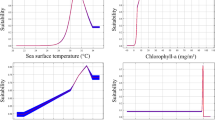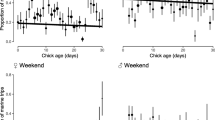Summary
Ring-billed gulls (Larus delawarensis) breeding at Dog Lake, Manitoba often feed by following tractors pulling cultivating implements around fields. Tractor-following gulls always land immediately behind the cultivating implement, where they feed on earthworms or grain. Afeer a feeding bout on the ground (patch residence time), gulls fly up, pursue the tractor and repeat the cycle. We use net energy maximizing (energy gained per unit time) and efficiency maximizing (energy gained per unit energy expended) models to make quantitative predictions of patch residence time, and compare these predictions to observations. If we assume flight speed to be constrained at the observed mean, the observations fall between the predictions of the two models, and the models explain approximately equal and highly significant proportions of the overall variation in patch residence time. If both flight speed and patch residence time are allowed to vary in the models, the efficiency maximizing model more closely predicts observed patch residence times, and the net energy maximizing model more closely predicts observed flight speeds. We discuss whether breeding ringbilled gulls may be truly intermediate between net energy and efficiency maximizing, and how measurements of flight speed may be useful in further investigations.
Similar content being viewed by others
References
Berger M, Hart JS, Roy OZ (1970) Respiration, oxygen consumption and heart rate in some birds during rest and flight. Z Vergl Physiol 66:201–214
Conway GR, Glass NR, Wilcox J (1970) Fitting non-linear models to biological data by Marquardt's algorithm. Ecology 51:503–507
Cummins KW, Wuychek JC (1971) Caloric equivalents for investigations in ecological energetics. Comm Int Assoc Theor Appl Limn 18:1–158
Drent RH, Daan S (1980) The prudent parent: energetic adjustments in avian breeding. Ardea 68:225–252
Houston AI (1987) Optimal foraging by parent birds feeding dependent young. J theor Biol 124:251–274
Houston AI, McNamara JM (1985) The variability of behaviour and constrained optimization. J Theor Biol 112:265–273
Houston AI, Schmid-Hempel P, Kacelnik AI (1988) Colony growth, mortality and foraging strategy in social insects. Am Nat (in press)
Kendeigh SC (1970) Energy requirements for existence in relation to size of bird. Condor 72:60–65
Oster G (1976) Modeling social insect populations. I. Ergonomics of foraging and population growth in bumblebees. Am Nat 110:215–245
Pennycuick CJ (1975) Mechanics of flight. In: Farner DS, King JR, Parkes KC (eds) Avian Biology. Vol. V; Academic Press, New York, NY, pp 1–75
Pyke, GH (1979) The economics of territory size and time budget in the golden-winged sunbird. Am Nat 114:131–145
Schmid-Hempel P (1987) Efficient nectar-collecting by honeybees. I. Economic models. J Anim Ecol 56:209–218
Schmid-Hempel P, Kacelnik AI, Houston AI (1985) Honeybees maximize efficiency by not filling their crop. Behav Ecol Sociobiol 17:61–66
Schmid-Hempel P, Schmid-Hempel R (1987) Efficient nectarcollecting by honeybees. II. Response to factors determining nectar availability. J Anim Ecol 56:219–227
Schnell GD, Hellack JJ (1979) Bird flight speeds in nature: optimized or a compromise? Am Nat 113:53–66
Schoener TW (1971) Theory of feeding strategies. Annu Rev Ecol Syst 2:369–404
Scott ML, Nesheim MC, Young RJ (1976) Nutrition of the chicken. ML Scott Assoc, Ithica
Sibly R, McCleery R (1985) Optimal decision rules for herring gulls. Anim Behav 33:449–465
Stephens DW, Krebs JR (1986) Foraging theory. Monographs in Behaviour and Ecology, Princeton University Press, Princeton
Tucker VA (1975) Flight energetics. Symp Zool Soc London 35:49–63
von Frisch K, Lindauer M (1955) Über die Fluggeschwindigkeit der Bienen und über ihre Richtungsweisung bei Seitenwind. Die Naturwissenschaften 42:377–385
Welham CVJ (1987) Diet and foraging behavior of Ring-billed Gulls breeding at Dog Lake, Manitoba. Wilson Bull 99:233–239
Yamamura N, Tsuji N (1987) Optimal patch time under exploitative competition. Am Nat 129:553–567
Author information
Authors and Affiliations
Rights and permissions
About this article
Cite this article
Welham, C.V.J., Ydenberg, R.C. Net energy versus efficiency maximizing by foraging ring-billed gulls. Behav Ecol Sociobiol 23, 75–82 (1988). https://doi.org/10.1007/BF00299890
Received:
Accepted:
Issue Date:
DOI: https://doi.org/10.1007/BF00299890




